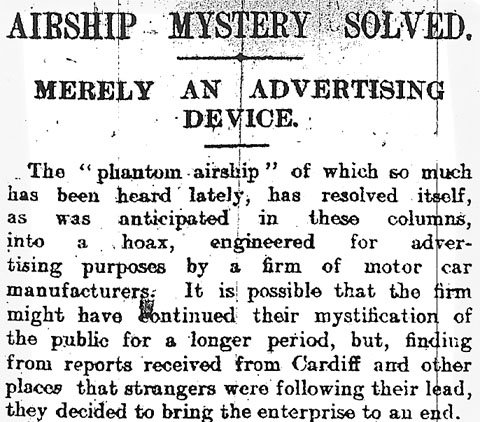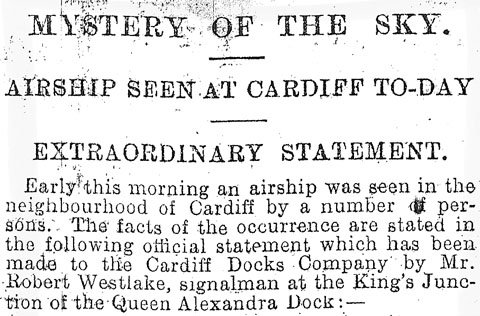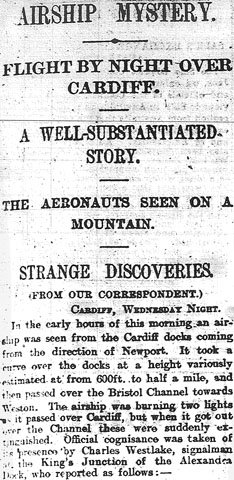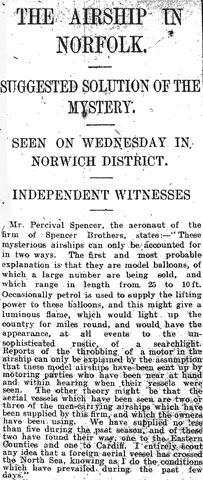The mighty Punch weighs in on the phantom airships today. Above is a rather wonderful full-page cartoon by Bernard Partridge, playing on the notion that the stories are part of the annual 'silly season' (usually in summer, still a month away):
The sea-serpent: "Well, if this sort of thing keeps on, it'll mean a dull August for me."
Interestingly, Partridge's own politics are very conservative, but his critique of the role of the press here -- the newspaper hoarding the sea serpent is peering at through his pince-nez is for the Daily Scare -- would sit quite comfortably with any radical.
Punch also has another, more heavy-handed, piece on the scareships under the title 'The everywhere ship' (p. 369), but it's really just a much more drawn out version of the equation of cigar-shaped objects from Germany with German cigars, as the Globe had done with greater concision yesterday. (It's quite possible that Punch hit the streets a day or two earlier than its publication date suggests, so the Globe might have been inspired by Punch.) Much funnier, to my mind, is 'The secret of the Army aeroplane' (p. 366) by A. A. M., who is none other than A. A. Milne. It's nothing to do with the scareships, but rather a deadly-accurate parody of the spy novels of William le Queux, whose Spies of the Kaiser is currently to be found in all good bookstores (and most of the bad ones too). In fact, it reads so like le Queux that it suggests that Poe's Law could be reformulated for the Edwardian 'enemies in our midst' genre: it's only because it's in Punch that I know it's a parody!

Back in the 'real' world, the phantom airship scare continues to unravel. Indeed, it is now confidently announced by the Standard that the 'Airship mystery [is] solved' (p. 11). Apparently, it was all a hoax perpetrated for the purposes of advertising (as the same paper had suggested on Friday). The precise identity of the hoaxers are not given, except that they work for 'a firm of motor car manufacturers'. (The Manchester Guardian says, on p. 7, that they are the British agents of a Continental motor car manufacturer; according to the Globe, p. 10, they are based in the West End. Autocar magazine may have more information.) The account in the Standard is fairly detailed, which does suggest there's something to it:
Two motor-cars were used, one carrying the balloon, a 20-h.p. motor, and a lot of bamboo poles for the steerable car, and the other half a dozen cylinders of compressed hydrogen. The first "ascent" was on the Chelmsford road, at Writtle. The balloon was secured with ropes and held to the wheel of one of the motor cars. Lights were put out or darkened, watchers were told off to give an alarm on the approach of strangers, and whilst the "steerable" was captive, toy fire-balloons were sent up to windward of it, and the engine of one of the motor cars was set working, the "silencer" being opened to increase the noise in order to give the impression to any nocturnal observer whose eye might be attracted by the balloon that he heard the whirring of its motor overhead.
Writtle is outside of Chelmsford in Suffolk. The 'airship' was also flown from Ipswich, Bury St Edmunds, and Newmarket Heath, all of which are in Suffolk. This is a problem, for while some scareships were seen in Suffolk, there were more from (admittedly nearby) Norfolk and, early on, Cambridgeshire. What's more, this stunt can hardly explain the sightings at Cardiff, Belfast or over the North Sea. And as we still don't know the name of the product being advertised, it's a pretty pointless advertising campaign. On the other hand, if the story was being made up to "explain" the sightings it would fit all of the evidence better. Perhaps it is the case that 'strangers were following their lead' in other parts of the country. And from recent experience we know that 'fire-balloons', or sky lanterns as they are sometimes called, can cause great consternation when seen from the ground.
There is also some hard evidence, in the form of a crashed airship. According to the Standard's information, the advertising airship was sent up on one last suicide mission near Dunstable, Bedfordshire, 'directed in such a way that it should come to grief quickly'. Attached to it was a note asking the finder to inform the owners (again, who?), who would pay them £5. The wreckage was found yesterday, and one L. White has stepped forward to claim his or her reward. The Globe describes (p. 10) the remains thus:
The bamboo framework was completely smashed up, and the two powerful lamps, radiator, and various pieces of machinery were scattered about.
The two lamps does sound like the strikingly consistent descriptions of the airship with two searchlights, it must be said.
The Globe also has the solution to another mystery! Or rather the Daily Telegraph does, and the Globe kindly passes the information along. The rumours of a huge cache of rifles in the heart of London are, it turns out, true. There are about a quarter of a million rifles -- described in one sentence as 'modern' and in the next as 'old Martinis' -- in a sub-basement of Lloyds Bank in the Strand, opposite the Law Courts. They were, it seems, purchased from the government by the Society of Miniature Rifle Clubs, for conversion into miniature rifles. It's suggested that Lord Roberts is 'not unaware' of them, which would fit with his enthusiasm for military training (and at one time, at least, he was president of the SMRC). So, just as with the scareships, it looks like the truth, while strange enough, is not nearly as exciting as fiction.
![]() This work is licensed under a Creative Commons Attribution-NonCommercial-NoDerivatives 4.0 International License.
Permissions beyond the scope of this license may be available at http://airminded.org/copyright/.
This work is licensed under a Creative Commons Attribution-NonCommercial-NoDerivatives 4.0 International License.
Permissions beyond the scope of this license may be available at http://airminded.org/copyright/.






Erik Lund
Shouldn't there be miniature cavalry clubs, too?
Ian Evans
But would there be enough Shetland ponies?
Brett Holman
Post authorYou have to start somewhere when building a miniature army! Hopefully they also paid attention to the less glamourous miniature ordnance corps, miniature staff college, etc.
Errol
Have you seen this ref to mystery airships in American in 1896/7?
http://www.irregularwebcomic.net/2312.html
Pingback:
Airminded · Saturday, 29 May 1909
Brett Holman
Post authorI haven't, thanks!
Pingback:
Airminded · Post-blogging the 1909 scareships: thoughts and conclusions
Pingback:
Airminded · Scareships over Australia — I
Pingback:
Thursday, 27 February 1913